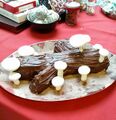Yule log (cake)
This article includes a list of general references, but it lacks sufficient corresponding inline citations. (March 2013) |
 A traditional Yule log (bûche de Noël) made with chocolate filled with raspberry jam | |
| Alternative names | Bûche de Noël |
|---|---|
| Course | Dessert |
| Region or state | Francophone countries, especially France |
| Serving temperature | Cold |
| Main ingredients | Genoise or other sponge cake, chocolate buttercream, or other icing |
A Yule log or bûche de Noël (French pronunciation: [byʃ də nɔɛl]) is a traditional Christmas cake, often served as a dessert, especially in France, Belgium, Luxembourg, Lebanon, Switzerland, Vietnam,[1] and Quebec, Canada. Variants are also served in the United States, United Kingdom, Cambodia, Scandinavia, Portugal, Spain, and Japan. Made of sponge cake, to resemble a miniature actual Yule log, it is a form of sweet roulade. The cake emerged in the 19th century, probably in France, before spreading to other countries.[2] It is traditionally made from a genoise, generally baked in a large, shallow Swiss roll pan, iced, rolled to form a cylinder, and iced again on the outside. The most common combination is basic yellow sponge cake and chocolate buttercream, though many variations that include chocolate cake, ganache, and icings flavored with espresso or liqueurs exist. Yule logs are often served with one end cut off and set atop the cake, or protruding from its side to resemble a chopped off branch. A bark-like texture is often produced by dragging a fork through the icing, and powdered sugar sprinkled to resemble snow.[3] Other cake decorations may include actual tree branches, fresh berries, and mushrooms made of meringue or marzipan. The name bûche de Noël originally referred to the Yule log itself, and was transferred to the dessert after that custom had fallen out of popular use. References to it as bûche de Noël or, in English, Yule Log, can be found from at least the Edwardian era (for example, F. Vine, Saleable Shop Goods (1898 and later).[4]
Gallery
See also
References
Citations
- ↑ "Quartz--France's most popular Christmas cake lives on in the bakeries of Vietnam". www.qz.com. 17 December 2016.
- ↑ "The Food Timeline--Christmas food history". www.foodtimeline.org. Retrieved 23 December 2020.
- ↑ Claiborne, Craig, The New York Times Cookbook, Harper & Row, New York, 1961; ISBN 978-0060107901, p. 545.
- ↑ Vine, Frederick T. (1907). Saleable Shop Goods for Counter-tray and Window: (including "popular Penny Cakes") : a Practical Book for All in the Trade. Office of the Baker and Confectioner.
General references
- "la Bûche de Noël" in: Le Calendrier Traditionnel, Voici: la France de ce mois, vol. 2, no. 17–21, Voici Press (1941).
- Albert Goursaud, Maurice Robert, La société rurale traditionnelle en Limousin: ethnographie, pp. 471, 474
- Claude Seignolle, Traditions populaires de Provence, pp. 84-87
- Arnold van Gennep, Manuel de folklore français contemporain, pt. 2, Du berceau à la tombe (1946)
External links
- Buche de Noel (via foodtimeline.org)
- Bûche de Noël in the online Culinary Heritage of Switzerland database.


